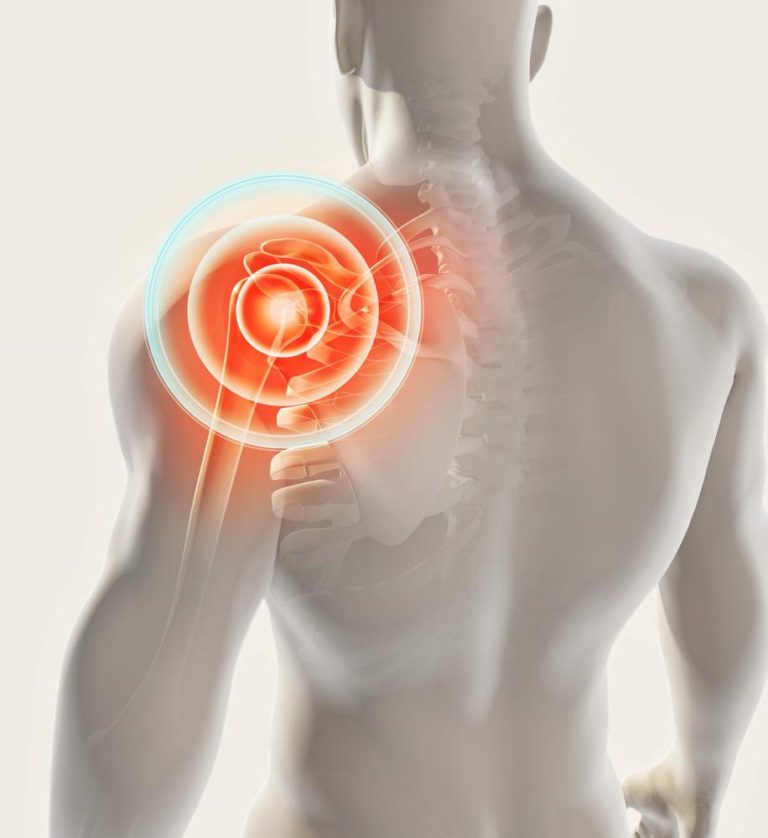Frozen Shoulder

Image source: Shutterstock
Frozen shoulder also known as Adhesive capsulitis is characterized by only pain initially and then progression to restricted joint range of motion of the glenohumeral joint along with pain. The condition recovers partially or completely over the course of time.
Stages of frozen shoulder
- Freezing stage (painful shoulder) (2-9 months) – The symptoms start with pain in the shoulder which usually starts after an injury or comorbidities. A patient may not be able to pinpoint the source of pain. The pain gets worse at night, and the patient may not be able to get relief from over-the-counter pain medications.
- Frozen stage (stiff shoulder) (4-6 months) – After a couple of months, the patient starts to feel better in terms of pain, but the shoulder becomes stiff. So, when a patient tries to move their shoulder, they don’t get the full range of motion. Movement becomes restricted and they start to feel difficulty in day-to-day tasks like wearing a jacket, lifting their arms, etc.
- Recovery or thawing stage (6-24 months) – All the symptoms will begin to improve and it will take approx. 6 months to 3 years to recover completely with a combination of medication and/or therapy.
Potential causes:
The exact cause of frozen shoulder is not known. statistics indicate that Females are affected more than males with the 2:1 ratio, and the elderly are more affected than the young population (Inayat et al 2017). The condition commonly affects the non-dominant shoulder and in approx. In approximately 12% of the cases, both the shoulders are affected (Toda K et al 2018).
Here are some common and uncommon causes of frozen shoulder, but even if you don’t fit any criteria, you can still get frozen shoulder:
- Diabetes – Diabetes is a condition where the body either fails to respond to the insulin or doesn’t produce enough insulin. Symptoms of diabetes are weight loss, increased appetite, increased thirst, fatigue, etc.
Image Source: ShutterstockDiabetes can severely affect your body if left untreated. In fact, it is found that people with diabetes have five times more chance to develop frozen shoulder than people without diabetes (Zreik etal 2016).
- Thyroid – The thyroid is a small gland in front of the neck. It produces the hormones that keep your bodily functions normal and keeps you energetic. When the thyroid gland is affected, not only the body but your shoulder also gets affected. A study found that out of 126 patients with frozen shoulder, 13.5% had a thyroid disorder (Milgrom 2008).
- Injury – Sometimes, when your shoulder is injured, it is kept immobile for a short duration to encourage healing, depending on the severity of the injury. This period of immobility can also make it susceptible to frozen shoulder. To avoid this, it is important that proper post-injury rehabilitation is taken.
Image source: Shutterstock
- Posture – Bad postural changes alter the normal alignment of the glenoid fossa, which leads to tension loss in the coracohumeral ligament and superior joint capsule. During overuse of the rotator cuff, the tensile stress over the capsular ligament increases. Over time the capsule gets thickened and fibrosis due to chronic inflammation.
Some other serious medical conditions like stroke or a mastectomy might also lead to Frozen shoulder
Symptoms of frozen shoulder:
One of the first frozen shoulder symptoms is that the patient experiences a dull pain that can flare anytime when they try to move his shoulder. There may also be neck pain sometimes. Some patients complain that the pain worsens at night and makes it difficult for them to sleep at night.
Most people believe that shoulder stiffness and limited range of motion are the classic signs of a frozen shoulder, but these symptoms are not associated with the early stages of the condition. There may be a reduced range of motion afterward. This is because the range of motion gets limited once the scar tissue starts to build in the shoulder capsule. It takes several months to develop a frozen shoulder.
So, the main symptoms are:
- Shoulder pain that gets worse during the night.
- Shoulder stiffness that makes it difficult to raise the arm.
- Limited range of motion.
- Dull pain.
What is the shoulder capsule, and how does it get affected in the frozen shoulder?
The shoulder complex is made up of three bones: humerus, clavicle, and scapula. The joint complex is covered with a capsule and in the frozen shoulder, the capsule starts to contract. The patient starts to form scar tissue called adhesions, and in addition to that, bursae present in the shoulder joint also start to stick together, which limits the movement of the shoulder, making it stiff and extremely painful.
Treatment
Non-steroidal anti-inflammatory drugs like ibuprofen and aspirin can reduce the pain and inflammation of the shoulder. If NSAIDs fail, your doctor may suggest other kinds of treatments like:
- A corticosteroid injection can be given to decrease the pain and increase the range of motion. Corticosteroid injections are useful in the early, painful stage as there is more inflammation in this stage than in the later stages when fibrous contracture is more prominent (Brue S, 2007).
- Surgery is rarely necessary, but if other treatments fail to bring relief, your doctor may suggest arthroscopic surgery.
- Manipulation under anesthesia – In this procedure, the surgeon moves the shoulder forcefully to stretch or tear the scar tissue, which increases the range of motion and helps with the tightening. The entire procedure is done under anesthesia. However, there are numerous risks involved, such as glenoid, humeral or scapular fracture, nerve palsy, rotator cuff injury, injuries to the brachial plexus or peripheral nerve (Neviaser AS,2010)
- Conservative treatment approaches like Physiotherapy
Physiotherapy treatment
- Freezing phase – Patients experience the most severe pain in this stage, so it is important to use pain-relieving techniques at this stage. The exercises used in this stage are gentle shoulder mobilization exercises like pendulum exercise, passive shoulder exercises like forwarding elevation and external rotation, and active-assisted exercises in internal rotation, extension, and horizontal adduction. To relieve the pain, an ice pack or hot pack can be applied before starting any of these exercises. Studies show that stretching with the application of moist heat can improve the extensibility of the muscles (Kelly M,2009).
Image source: Shutterstock
- The patient is taught short-duration exercises in a pain-free range of motion. Pendulum exercises are used in abduction, flexion, and circular motion. Pulley exercises can also be started, but it should be remembered that aggressive stretching beyond the pain-free range can affect the outcome of the treatment, particularly in the early stage of the condition.
- Frozen phase – Similar to the freezing phase, exercises should be continued within the tolerated limit. Stretching exercises for the back and the chest muscle should be incorporated. At this stage, strengthening exercises are also added to maintain muscle strength. Isometric exercises are the best exercises to start at this stage as these can be done without increasing the shoulder pain. In addition, mobilization with movement is more effective than stretching alone (Doner, 2013).
- Thawing phase – In this phase, there is a slow return of range of motion. Continuing strengthening exercises is a must after the limited movement in the shoulder for a few months.
Image Source: Shutterstock
- As irritability level decreases, patients in this stage can perform more mobility exercises and stretches comfortably using devices like a pulley (Kelly M, 2009). Exercises can be progressed from isometric to a full range of motion using a resistance band, free weights, and weight machine.
- Treatment should be customized according to the stages of the disease as it progresses in a predictable manner (Dias R, 2005). However, it is important to consider the cause of the disease before providing any treatment.
Electrotherapy in the frozen shoulder:
- For pain relief in the first stage, TENS and IFT are applied. Both these modalities offer electrical stimulation to the muscles and provide pain relief in the frozen shoulder. A study found that both electroacupuncture and IFT can reduce the score of the visual analog scale significantly if given in combination with shoulder exercises (Cheing, 2008).
- One study also concluded that Low-level laser therapy (LLLT) plus exercise for eight weeks is more effective than exercises alone in the frozen shoulder (Page, 2014).
- Moist heat can also be given before starting any exercise regimen to reduce the stiffness and increase the blood supply of the area.
- With the help of experts in Progressive Care, you can get a holistic approach to your problem and come through the issue with ease.
References:
- Brue S et al. Idiopathic adhesive capsulitis of the shoulder: a review. Knee Surg Sports Traumatol Arthrosc. 2007. 15:1048-1054
- Inayat, F., Ali, N. S., Shahid, H., & Younus, F. (2017). Prevalence and Determinants of Frozen Shoulder in Patients with Diabetes: A Single Center Experience from Pakistan. Cureus, 9(8), e1544. https://doi.org/10.7759/cureus.1544
- Toda, K. (2018). Left and Non-Dominant Shoulders Were More Frequently Affected in Patients with Frozen Shoulder: A Systematic Review and Meta-Analysis. Orthopedic & Muscular System, 07(04). https://doi.org/10.4172/2161-0533.1000258
- Zreik NH, Malik RA, Charalambous CP. Adhesive capsulitis of the shoulder and diabetes: a meta-analysis of prevalence. Muscles Ligaments Tendons J. 2016 May 19;6(1):26-34. doi: 10.11138/mltj/2016.6.1.026. PMID: 27331029; PMCID: PMC4915459.
- Milgrom, C. (2008). Risk factors for idiopathic frozen shoulder. PubMed. https://pubmed.ncbi.nlm.nih.gov/18605360/
- Neviaser AS, Hannafin JA. Adhesive Capsulitis: A Review of Current Treatment. The Am J Sports Med 2010;38:2346-56.
- Kelley M, Mcclure P, Leggin B. Frozen shoulder: Evidence and a proposed model guiding rehabilitation. J Orthop Sports Phys Ther 2009;39:135-148
- Doner, G. (2013, January). Evaluation of Mulligan’s technique for adhesive capsulitis of the shoulder. PubMed. https://pubmed.ncbi.nlm.nih.gov/23037929/
- Kelley M, Mcclure P, Leggin B. Frozen shoulder: Evidence and a proposed model guiding rehabilitation. J Orthop Sports Phys Ther 2009;39:135-148
- Dias R, Cutts S, Massoud S. Frozen shoulder. BMJ 2005; 331:1453-6
- Cheing, G. L. Y. (2008). Effectiveness of electroacupuncture and interferential electrotherapy in the management of frozen shoulder. PubMed. https://pubmed.ncbi.nlm.nih.gov/18292916/
- Page, M. J. (2014, October 1). Electrotherapy modalities for adhesive capsulitis (frozen shoulder). PubMed. https://pubmed.ncbi.nlm.nih.gov/25271097/

Progressive Care Physiotherapy
Progressive Care Physiotherapy Management is the best service in the physiotherapy industry. It is known for providing the best service and cutting-edge technology to help speed up recovery, while also being able to offer various treatment options that are tailored to your specific needs.
For More details call us on 9618906780
